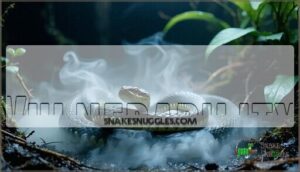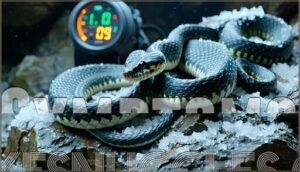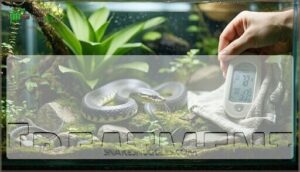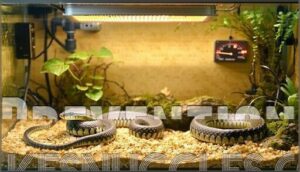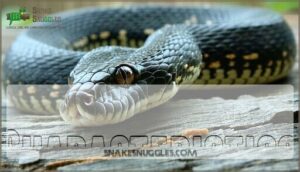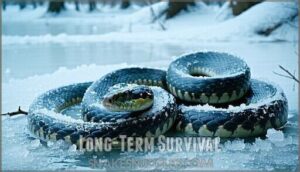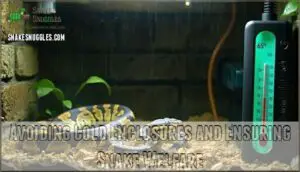This site is supported by our readers. We may earn a commission, at no cost to you, if you purchase through links.

Hypothermia sets in quickly, leaving them lethargic and immobile as their body temperature drops below safe levels. Unlike mammals, snakes can’t generate their own heat, so they’re completely dependent on external warmth to survive.
Cold exposure triggers organ failure if prolonged, and what starts as sluggish behavior can rapidly become a medical emergency requiring immediate intervention to prevent death.
Table Of Contents
- Key Takeaways
- Consequences of Cold Enclosures
- Respiratory Infections in Snakes
- Hypothermia and Its Effects
- Digestive Disruptions and Refusal of Food
- Avoiding Cold Enclosures and Ensuring Snake Welfare
- Frequently Asked Questions (FAQs)
- What happens if a snake gets too cold?
- What temperature is too cold for snakes?
- Why do Snakes Hate cold weather?
- Can snakes go dormant if temperature is too cold?
- What happens if you don’t warm up a snake?
- Will a snake die if it stays in a cold enclosure?
- How do snakes regulate their body temperature in cold enclosures?
- Can snakes freeze to death in winter?
- How quickly do cold temperatures affect snakes?
- What temperature kills snakes instantly?
- Conclusion
Key Takeaways
- Your snake’s immune system crashes in cold temperatures, making it vulnerable to deadly respiratory infections like bacterial pneumonia that can kill if left untreated.
- Cold exposure triggers complete digestive shutdown, causing your snake to regurgitate food and refuse meals as its metabolism can’t function properly without adequate heat.
- Hypothermia develops quickly since snakes can’t generate their own body heat, leaving them completely dependent on external warmth to maintain life-sustaining organ functions.
- You must maintain proper heating systems and monitor temperatures daily, as even brief drops below 65°F can trigger serious health problems or death in most snake species.
Consequences of Cold Enclosures
When you don’t maintain proper temperatures in your snake’s enclosure, you’re setting up a dangerous situation that can quickly spiral into serious health problems. Cold enclosures trigger a cascade of physiological disruptions, including respiratory infections, hypothermia, and complete digestive shutdown that can prove fatal if left uncorrected.
Respiratory Infections
Cold temperatures put your snake at serious risk for respiratory infections. When exposed to cold environments, your snake’s immune system weakens dramatically, creating perfect conditions for bacterial pneumonia, fungal infections, and viral causes to take hold. Environmental factors like poor ventilation worsen the problem. A vet can perform diagnostic imaging techniques for a proper diagnosis.
Watch for these warning signs:
- Thick nasal discharge that won’t clear
- Wheezing sounds during breathing
- Open-mouth breathing or gasping
- Complete loss of appetite
- Lethargy and decreased activity
Preventative care through proper heating prevents most respiratory infections in snake health management.
Hypothermia
Unlike respiratory infections, hypothermia affects your snake’s entire body systems when cold temperatures drop below safe levels. Snake hypothermia creates extreme lethargy and immobility, signaling immediate danger. Your pet’s metabolism crashes, leading to immune suppression that makes recovery harder. As ectotherms, snakes require specific environmental conditions to thrive, and improper husbandry can substantially contribute to illness.
| Body System | Effect | Severity |
|---|---|---|
| Nervous System | Nerve damage, tremors | Severe |
| Circulation | Organ failure risk | Critical |
| Behavior | Brumation risks, inactivity | Moderate |
Extended cold exposure requires slowly warming your snake over 4-6 hours to prevent shock. Watch for rolled posture and complete stillness—these aren’t normal brumation behaviors but emergency signals demanding your immediate attention.
Digestive Disruptions
When your snake’s enclosure drops below ideal temperatures, digestive disruptions become a serious concern. Cold environments trigger metabolic slowdown, causing your snake to struggle with proper digestion and nutrient absorption.
Here’s what happens when snake digestion fails:
- Regurgitation causes immediate loss of consumed prey
- Impaired digestion prevents essential nutrient processing
- Anorexia risks develop as your snake stops eating entirely
- Regurgitation or vomiting becomes frequent without adequate warmth
Monitor temperatures closely—your snake can’t digest food properly in cold conditions.
Respiratory Infections in Snakes
When you expose your snake to cold temperatures, you’re setting up the perfect conditions for respiratory infections to take hold. Cold stress weakens your snake’s immune system, making it vulnerable to bacterial and viral pathogens that attack the respiratory tract.
Vulnerability
Vulnerability strikes when your snake’s immune system can’t handle cold temperatures. When exposed to inadequate heating, your pet becomes a sitting duck for respiratory infections that can lead to snake death if untreated. Cold stress compromises their natural defenses, making even minor health issues potentially fatal. Proper enclosure hygiene is also essential for snake health.
Several factors contribute to a snake’s vulnerability to cold-related health issues:
- Species Sensitivity: Some snakes tolerate cold better than others based on their natural habitat
- Age Factors: Younger and older snakes face higher risks during temperature drops
- Health Status: Previously sick snakes can’t fight off infections as effectively
- Habitat Loss: Poor enclosure conditions multiply vulnerability to respiratory problems
- Limited Mobility: Cold snakes move less, reducing their ability to seek proper temperatures
Your snake’s survival depends on maintaining proper heat levels consistently.
Symptoms
Several warning signs appear when your snake becomes lethargic from cold temperatures. Watch for appetite loss, scale dryness, and concerning behaviors like regurgitation or vomiting. Your snake can’t digest food properly in cold conditions, leading to these digestive issues. Tremors may develop as the nervous system struggles.
| Physical Symptoms | Behavioral Changes |
|---|---|
| Scale dryness | Lethargy signs |
| Tremors | Appetite loss |
| Nasal discharge | Reduced movement |
| Labored breathing | Hiding behavior |
Without prompt intervention, respiratory infections develop and your snake dies from prolonged cold exposure. Open-mouth breathing is a key indicator of snake respiratory distress.
Treatment
Once you’ve spotted the telltale signs of respiratory infection, swift veterinary intervention becomes your snake’s lifeline. Your veterinarian will prescribe targeted medication options, usually antibiotics administered orally or through injection. Rewarming techniques help restore proper temperature gradually, while hydration support ensures your snake doesn’t become dehydrated during recovery. Long-term care involves monitoring for recurring health problems and maintaining consistent heating systems. Effective treatment also involves understanding respiratory infection causes.
Here’s what effective treatment involves:
- Immediate veterinary consultation – Don’t wait when breathing becomes labored
- Prescribed antibiotic therapy – Usually lasts 10-14 days for complete recovery
- Controlled rewarming process – Prevents shock from rapid temperature changes
- Ongoing hydration monitoring – Dehydration compounds hypothermia recovery challenges
Diagnostic Tests
How can you tell if your snake’s respiratory infection needs immediate veterinary care? When cold stress compromises your snake’s immune system function, accurate diagnosis becomes critical. Your veterinarian will use multiple diagnostic approaches to identify the specific pathogen and assess overall health.
Key diagnostic methods include:
- Physical Examination – Palpation detects internal swellings while oral cavity inspection reveals edema or discharge
- Blood Analysis – Complete blood counts identify infections and assess organ function affected by cold exposure
- Imaging Techniques – X-rays visualize lung changes and digestive blockages common in hypothermic snakes
Additional tests like Fecal Exams check for parasites that cold stress can worsen, while Biopsy Analysis assesses cellular damage from chronic exposure. Veterinarians use these advanced diagnostic techniques to gather essential information about a snake’s health status.
These thorough evaluations help your veterinarian spot health issues early, especially kidney issues that often accompany respiratory infection symptoms in cold-stressed reptiles.
Prevention
Prevention starts with maintaining proper thermal gradients in your snake enclosure. Install a reliable heat source with backup heating to prevent temperature drops. Monitor ambient temperature daily using quality thermometers.
| Prevention Method | Temperature Range | Frequency |
|---|---|---|
| Basking Setup | 85-95°F | Daily check |
| Enclosure Insulation | 75-80°F ambient | Weekly inspect |
| Heating Methods | Species-specific | Continuous monitor |
Understanding your snake’s species needs helps you maintain temperature consistently and avoid respiratory infections.
Hypothermia and Its Effects
When your snake’s body temperature drops below its ideal range, hypothermia sets in and triggers a cascade of life-threatening physiological changes that affect every major organ system.
You’ll notice your snake becoming lethargic, refusing food, and displaying weakened immune responses that make it vulnerable to secondary infections and potentially fatal complications.
Characteristics
Recognizing hypothermia in your snake isn’t always obvious, but you’ll notice specific warning signs. When these coldblooded, ectothermic animals can’t regulate their body temperature properly, their snake thermoregulation system fails. You’ll see clear behavioral adaptations as they desperately seek warmth, but their ectothermic nature makes recovery challenging.
- Lethargy and reduced movement despite normal lighting
- Dry, dull scales that lack their usual shine
- Sunken eyes indicating dehydration stress
- Complete loss of appetite and feeding response
Their cold tolerance varies by species, but prolonged exposure triggers brumation habits as survival instincts kick in.
Starvation and Dehydration
When your snake’s body temperature drops, metabolic slowdown triggers a cascade of dangerous effects. Your pet’s digestive system basically shuts down, making it impossible for the snake to digest food properly. This leads to immediate food refusal as body functions prioritize survival over nutrition.
Without proper digestion, weight loss accelerates rapidly, followed by muscle atrophy as the body consumes its own tissue for energy. Reduced activity becomes pronounced as your snake conserves whatever energy remains.
Unfortunately, prolonged starvation weakens critical organs, potentially causing permanent organ damage that threatens your snake’s long-term health and survival.
Tolerance to Cold
While starvation weakens snakes, cold tolerance varies dramatically between species. Cold-Hardy Species like garter snakes handle freezing temperatures better than tropical pythons, which suffer at 40°F. Geographic Variation explains this difference—northern snakes evolved stronger snake cold tolerance through natural selection.
Your pet’s snake temperature tolerance depends on its origins. Species from warmer climates can’t handle cold temperatures that temperate snakes survive easily. Metabolic Slowdown helps some species endure brief cold snaps, but even hardy snakes need proper Insulation Methods.
Understanding your snake’s specific cold tolerance prevents dangerous temperature drops.
Brumation Instinct
When cold temperatures hit, your snake goes dormant through brumation—nature’s energy conservation strategy. Brumation triggers include dropping temperatures around 60°F, prompting reduced snake activity patterns. Species differences affect brumation length; some snake species brumate for weeks while others extend months.
During this brumation behavior, your snake’s metabolism slows dramatically, preserving essential energy reserves. Think of it as hitting the "pause button" on life.
Post-brumation care requires gradual temperature increases to safely restart normal functions.
Long-Term Survival
While brumation instinct helps snakes survive short cold periods, long-term exposure tells a different story. Your snake’s survival depends on genetic adaptation and environmental impact over extended timeframes. Cold tolerance varies dramatically between species, but hypothermia becomes deadly when it persists beyond what their evolutionary changes can handle.
Here’s what determines snake survival during prolonged cold:
- Resource availability – Fat reserves deplete faster than you’d expect
- Immune system crashes, inviting deadly infections
- Brumation strategies fail when temperatures stay too low
- Energy conservation can’t overcome sustained metabolic stress
- Recovery time lengthens with each cold exposure cycle
Species from warmer climates face the greatest risk. Juveniles lack the developed thermoregulatory mechanisms that adults possess. Without proper heating, your snake’s body simply can’t maintain the biological processes needed for survival. Even brief exposures below freezing can cause permanent damage, while sustained cold leads to organ failure and death.
Digestive Disruptions and Refusal of Food
When you expose your snake to cold temperatures, you’ll notice it refuses food because its digestive system can’t function properly without adequate heat.
Cold temperatures slow your snake’s metabolism to a crawl, making digestion nearly impossible and often causing regurgitation of any food it does consume.
Thermoregulation Role
Beyond the immediate dangers of hypothermia, you’ll discover that thermoregulation plays a fundamental role in your snake’s digestive health. As ectothermic animals, snakes can’t generate their own body heat like you do. They’re completely dependent on external heat sources to maintain proper body temperature for digestion.
Your snake’s digestive system works like a finely tuned engine that requires specific temperatures to function. Without adequate warmth, their metabolism slows dramatically, making it impossible to break down food properly. This ectothermic dependence means they’ll actively seek basking spots when temperatures drop.
Here’s how temperature regulation affects digestion:
- Basking importance drives snakes to spend hours under heat sources after eating
- Temperature gradients in their environment allow them to fine-tune their body heat
- Behavioral regulation includes moving between warm and cool zones throughout the day
- Brumation triggers activate when consistent cold temperatures signal winter survival mode
When your snake can’t achieve proper body temperature through thermoregulation, their entire digestive process shuts down, leading to serious health complications.
Regurgitation
One simple truth about snakes: when your pet snake can’t digest properly due to cold temperatures, regurgitation becomes a serious concern. Cold environments trigger digestion impairment, forcing your snake to expel undigested snake food as a protective mechanism.
This stress-induced response occurs because metabolic slowdown prevents proper breakdown of prey items. Your snake literally can’t digest food efficiently when temperatures drop below ideal levels. The regurgitated food process causes significant nutritional loss, weakening your pet further.
During brumation effects, wild snakes naturally stop eating, but captive snakes may continue feeding despite inadequate heating. When snakes regurgitate, they lose beneficial gut bacteria essential for future digestion.
Monitor temperatures carefully—your snake’s digestive system depends on consistent warmth to function properly.
Energy Conservation
When your snake’s environment drops below ideal temperatures, it triggers a metabolic slowdown that’s naturally an emergency protocol. Your pet will refuse food and become increasingly lethargic as snake activity decreases dramatically. This isn’t stubbornness—it’s survival instinct kicking in through brumation strategies.
Here’s what you’ll observe during this energy conservation phase:
- Complete food refusal – Your snake won’t eat anything, no matter how tempting
- Extended hiding periods – They’ll stay tucked away for days or weeks
- Minimal movement – Basic functions only, like a living statue
- Reduced waste production – Their body basically hits the pause button
This activity reduction acts as a natural insulation method, allowing your snake to preserve essential energy reserves. While brumation helps improve survival rates in wild populations, captive snakes shouldn’t experience prolonged cold exposure. Understanding snake behavior during these periods helps you recognize when immediate action’s needed.
Monitoring Temperature
Temperature monitoring isn’t just good practice—it’s your snake’s lifeline. Install accurate thermometers at both the basking spot and cool end to track temperature gradients throughout the enclosure. Digital thermometers provide precise readings, while remote monitoring systems alert you to dangerous fluctuations.
Check temperatures twice daily, focusing on the snake temperature range your species needs. Night temperatures shouldn’t drop below safe minimums, as proper temperature regulation directly impacts digestion.
Think of monitoring as your early warning system—catching problems before your snake’s health suffers keeps everyone happy.
Stress Factor
Cold stressors trigger a cascade of problems that’ll make your snake miserable. When temperatures drop, your pet’s immune system takes a hit, leaving them vulnerable to infections and behavioral changes. Think of it like catching a cold when you’re already exhausted – everything becomes harder.
Cold shock syndrome disrupts their ability to process food, creating captivity stress that compounds existing issues. Your snake can’t digest properly in these conditions, leading to immune suppression and potential brumation stress.
Avoiding Cold Enclosures and Ensuring Snake Welfare
You’ll want to check your snake’s enclosure temperature daily using reliable thermometers, as even brief cold exposure below 65°F can trigger serious health problems. Prevention through proper heating equipment and regular monitoring protects your snake from respiratory infections, digestive issues, and potentially fatal hypothermia.
Regular Temperature Checks
Establishing consistent monitoring with accurate thermometers acts as your first defense against temperature-related health risks. Digital thermometers provide precise readings to verify your snake’s temperature requirements are met throughout their enclosure. You can find a suitable reptile thermometer online.
- Use reliable digital thermometer systems to track temperature range fluctuations in both warm and cool zones
- Monitor behavioral cues like excessive hiding or reduced activity that signal temperature problems
- Maintain proper gradient maintenance through regular enclosures temperature assessments and remote monitoring when possible
External Factors
Beyond monitoring your snake’s habitat, several environmental factors can throw your pet’s temperature off balance. Ambient temperature fluctuations in your home directly affect the enclosure’s warmth, especially during seasonal changes. Geographic location matters too—winter heating bills spike when you’re battling harsh cold weather outside.
Power outages pose serious threats, cutting off basking sites when your snake needs them most. When your heating breaks down unexpectedly, shelter availability becomes critical.
Sudden temperature changes from drafty windows or air conditioning can create dangerous cold pockets, making consistent environmental control your snake’s lifeline.
Emergency Measures
Power outages and heating system failures can turn your snake’s cozy home into a danger zone. When your heating breaks down, immediate warming becomes your top priority. Hypothermia and cold shock syndrome develop quickly without an external heat source. Here’s your emergency action plan:
- Use insulated containers with commercial reptile heat packs (never direct contact)
- Provide hydration support while avoiding food until temperatures stabilize
- Implement quarantine protocol if respiratory symptoms appear
- Seek veterinary intervention for severe cases showing neurological signs
Remember, gradual warming prevents additional stress on your snake’s already compromised system. You can find various reptile heat pack options online.
Duration of Cold Exposure
Understanding exposure length helps you protect your snake from hypothermia and cold shock syndrome. Most species can’t survive freezing temperatures beyond 24-48 hours without shelter.
Recovery time varies by species variation – northern snakes handle months of cold, while tropical species suffer within days. Body temperature drops create cumulative effects that worsen over time.
Prolonged exposure causes irreversible damage to organs and nerves. Your snake’s thermoregulation abilities and cold tolerance determine survival, making timing critical for their health.
Prevention Measures
Preventing cold-related health issues starts with proper thermal gradients in snake enclosures. Install reliable heat sources like under-tank heaters or ceramic heat emitters to maintain consistent temperature zones. Use digital thermometers for accurate environmental monitoring—analog gauges can’t be trusted when your snake’s life depends on precision.
Create backup heating equipment plans for power outages, including battery-powered heat pads or emergency relocation strategies. Check temperature control systems weekly, especially during seasonal changes. Remember, proper thermoregulation isn’t optional—it’s the foundation of snake health and survival.
Effective snake care also involves understanding heat lamp requirements to guarantee a suitable environment.
Frequently Asked Questions (FAQs)
What happens if a snake gets too cold?
When you’re dealing with a chilly snake, think of it as nature hitting the "slow button."
Your snake’s metabolism drops dramatically, causing lethargy, appetite loss, and digestive troubles that can turn serious quickly.
What temperature is too cold for snakes?
Temperatures below 65°F become dangerous for most snakes. You’ll notice they can’t regulate their body temperature properly, leading to slowed metabolism, digestive issues, and potential respiratory infections if exposed too long.
Why do Snakes Hate cold weather?
Cold weather hits snakes like a brick wall. You’re dealing with ectothermic animals that can’t generate their own body heat.
When temperatures drop, their metabolism crashes, digestion stops, and they risk hypothermia or death.
Can snakes go dormant if temperature is too cold?
Yes, you’ll see snakes enter brumation when temperatures drop too low. They’ll slow their metabolism, become inactive, and seek shelter in burrows or dens to survive cold periods safely.
What happens if you don’t warm up a snake?
Like a telegraph operator ignoring urgent messages, you’re risking your snake’s life. Without proper warmth, your snake’s metabolism crashes, digestion stops, and respiratory infections develop. Your pet becomes lethargic, stops eating, and may die.
Will a snake die if it stays in a cold enclosure?
Absolutely, your snake can die if kept too cold. Prolonged exposure to temperatures below 65°F shuts down essential functions, causing respiratory infections, organ failure, and death.
How do snakes regulate their body temperature in cold enclosures?
When temperatures drop, you’ll notice your snake can’t generate its own heat like you do. Instead, it seeks warm spots, burrows deeper into substrate, or finds hiding places to conserve body heat and avoid dangerous temperature drops.
Can snakes freeze to death in winter?
Snakes can freeze to death when temperatures drop below 32°F. They’ll enter brumation to survive winter, but inadequate shelter or extreme cold proves fatal for these cold-blooded creatures.
How quickly do cold temperatures affect snakes?
When winter’s chill creeps in, you’ll notice your snake’s metabolism hitting the brakes within hours. **Cold temperatures slow digestion, breathing, and movement almost immediately.
Your serpent becomes lethargic and refuses food as its body desperately conserves energy.
What temperature kills snakes instantly?
Freezing temperatures around 32°F (0°C) can kill you’re snake within hours. However, there’s no "instant death" temperature – it’s more about exposure time and your snake’s species tolerance.
Conclusion
Proper temperature control separates thriving snakes from suffering ones. What happens when a snake gets too cold isn’t just uncomfortable – it’s potentially fatal.
You’ve learned that respiratory infections, hypothermia, and digestive shutdown create a dangerous cascade of health problems. Your snake can’t generate its own warmth, making consistent heating essential for survival.
Monitor temperatures daily, maintain proper gradients, and act quickly if problems arise. Prevention beats treatment every time in reptile care.
- https://bouldercountyopenspace.org/i/science/a-winter-snakes-tale/
- https://www.vetlexicon.com/exotis/reptiles/internal-medicine/articles/hypothermia/
- https://sciencenotes.org/what-is-brumation-definition-and-examples/
- https://www.petmd.com/reptile/conditions/systemic/hypothermia-reptiles
- https://gohikevirginia.com/where-do-snakes-go-in-the-winter/

